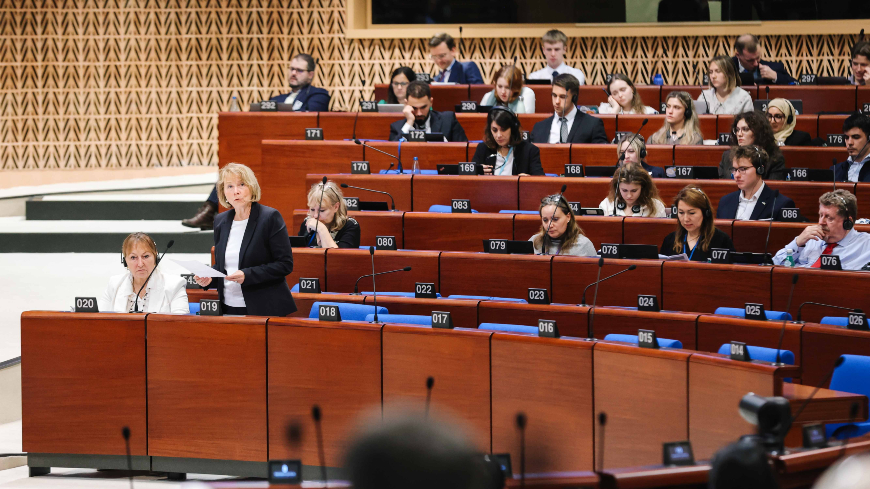Mykola Tochytskyi: “Destroying Ukrainian culture means destroying the Ukrainian nation”.
From the start of its invasion of Ukraine in February 2022, Russia has systematically targeted its artistic and cultural heritage, seeking also to “rewrite history” to better justify its aggression. During the debate that preceded the adoption of a declaration on the destruction of Ukraine's cultural heritage on 15 October 2024, the Congress not only called for Russia to comply with international rules on the protection of cultural property in times of war, but also emphasised the genocidal dimension of the attacks on cultural heritage, which are designed to undermine the very foundations of Ukrainian identity. It hopes that saving objects and property that have been destroyed or have disappeared will be one of the priorities in rebuilding the country.
The Minister of Culture and Strategic Communications of Ukraine, Mykola Tochytskyi, drew up the horrific list of the destruction caused by Russia, with almost 1 200 sites destroyed, including 117 of national importance, as well as over 2 000 cultural institutions damaged, of which 368 have been totally destroyed. “History and culture are paying a heavy toll for the war and it is no coincidence that they are being attacked because it is Ukraine’s very identity and nature that are being attacked through them,” he said. In his view, the Congress declaration would be a clear reminder to the aggressors that their actions would not go unpunished. Mykola Lukashuk, Chair of Dnipropetrovsk Regional Council, noted that in his region, Russia was destroying everything which Ukraine had preserved or built: since February 2022, over 400 sites and buildings, including Odessa cathedral, had been hit by Russian shells; many museums had been hit or were under threat, along with their collections and, of course, their staff.
The destruction of heritage as a form of genocide
When presenting the Congress declaration, Martine Dieschburg-Nickels (Luxembourg, L, ILDG) cited the symbolic example of the destruction of Mariupol theatre and said that, apart from the destruction of monuments, the war also involved the looting of libraries and museums, as well as illegal archaeological digs. Gunn-Marit Helgesen (Norway, R, EPP/CCE) referred to the “genocidal will” of the Russian aggressor – as did several other subsequent speakers in the debate – before presenting initiatives that could be taken by European local and regional authorities. Above all, it would be necessary to develop and expand partnerships with Ukraine’s devastated towns, cities and regions, while also helping them to record their losses in the Register of Damage. Other initiatives could help Ukrainian heritage, in particular documentation and inventory work and the establishment of cultural routes in the regions concerned once peace had been restored. Moreover, the Council of Europe had adopted several conventions on heritage protection, including the Faro and Nicosia conventions, which needed to be publicised, signed and ratified more widely.
Ukraine’s cultural heritage is also Europe’s cultural heritage
During the debate, Günther Bergmann (Germany, R, EPP/CCE) said that North-Rhine Westphalia had been taking part in the restoration of Ukraine’s historic architectural heritage for several years and would “do so even more after the war.” Thibaud Guignard (France, L, EPP/CCE) said he had works by Ukrainian painters hanging in his office and called on all mayors also to develop exchanges and partnerships with Ukrainian artists. Above all, he said, it should not be forgotten that attacking Ukrainian heritage meant attacking European heritage as a whole.
Several Ukrainian members gave moving descriptions of the destruction waged on their cities, while Ukrainian youth delegate Sofiia Bohdanova also referred to the millions of books burnt and the school textbooks replaced by ones glorifying the Russian “special military operation.” She also highlighted the devastation of the Crimean Tatars’ cultural heritage, with at least 150 000 objects destroyed. “If we lose our identity, our nation will disappear,” she said in conclusion. For his part, Estonian youth delegate Henrik Harjus referred to the theft of Ukrainian archaeological artefacts by Russia, in particular that exposed recently following the interception at a customs post of a lorry full of thousands of them. Apart from cultural property alone, Mélanie Lepoultier (France, L, ILDG) called for journalists working on the spot to be better supported and protected, as they were the ones who informed us about what was happening on the ground.
However, the deliberate destruction of cultural heritage was not confined to Ukraine alone, as pointed out by the Armenian, Georgian and Turkish delegates, with the latter condemning, in particular, the impact of such destruction during the conflict in Palestine and Lebanon. Danish youth delegate Tarik Deljkovic, whose family originally came from Bosnia and Herzegovina, underlined the scale of the losses suffered by that country’s heritage 30 years ago, and the desire expressed thereafter never to see that again. His question to the participants was: “have we already forgotten that lesson?”
Lastly, Christian Weis (Luxembourg, L, EPP/CCE) presented the twinnings which his town of Esch-sur-Alzette had established with Ukrainian municipalities, helping to strengthen co-operation involving heritage and culture. In their conclusions, all the speakers stressed that such twinnings and partnerships were one of the most effective ways of saving and restoring Ukrainian cultural heritage.
***




